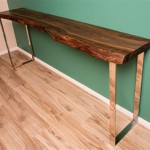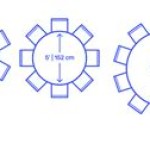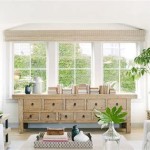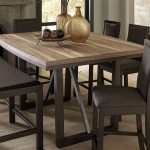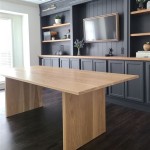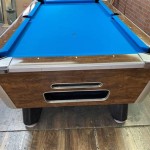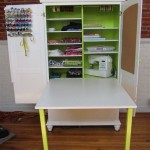Round Metal and Wood End Table: A Study in Form, Function, and Versatility
The round metal and wood end table represents a confluence of industrial durability and organic warmth, making it a popular choice for interior designers and homeowners alike. This furniture piece, typically small in stature, provides a valuable surface for various applications while contributing to the overall aesthetic of a room. Its construction, combining the strength of metal with the natural beauty of wood, allows it to seamlessly integrate into diverse interior styles, ranging from modern minimalist to rustic farmhouse.
The core appeal of a round metal and wood end table lies in its functional flexibility. It can serve as a convenient spot to place a beverage, a book, a lamp, or decorative accessories. Its circular shape often makes it a more space-conscious choice compared to square or rectangular end tables, particularly in smaller rooms or areas with limited maneuvering space. Moreover, the combination of materials lends itself to a visually interesting design that can enhance the character of any living space.
The construction of these end tables typically involves a metal frame or legs that provide structural support, coupled with a wooden tabletop. The type of metal used can vary, with options including steel, iron, aluminum, and brass, each offering different aesthetic properties and levels of durability. Similarly, the wooden tabletop can be crafted from various hardwoods like oak, maple, walnut, or softer woods like pine, each possessing distinct grain patterns, colors, and resistance to wear and tear.
Material Choices and Their Impact on Durability and Aesthetics
The selection of materials for both the metal and wood components significantly influences the end table's durability, aesthetic appeal, and overall cost. For the metal framework, steel is a common choice due to its high strength-to-weight ratio and relative affordability. Steel frames are usually powder-coated or painted to prevent rust and corrosion, and to provide a consistent color finish. Iron, while heavier than steel, offers a more rustic and industrial look, and is often finished with a clear coat to showcase its natural texture and color variations. Aluminum, being lightweight and corrosion-resistant, is suitable for outdoor or high-humidity environments. Brass offers a touch of elegance and sophistication, though it can be more expensive and requires regular polishing to maintain its luster.
The choice of wood for the tabletop is equally crucial. Hardwoods like oak, maple, and walnut are prized for their durability and resistance to dents and scratches. Oak, with its prominent grain patterns, is a popular choice for farmhouse and traditional styles. Maple offers a smoother, more uniform surface and is often stained to achieve a specific color. Walnut boasts a rich, dark color and a distinctive grain, adding a touch of luxury to the end table. Softer woods like pine are more affordable but are more susceptible to damage. Pine is often used in rustic or distressed designs, where minor imperfections are considered part of the aesthetic. The wood can be finished with various types of coatings, including varnish, lacquer, oil, and wax, each offering different levels of protection and sheen.
The finish applied to both the metal and wood components also plays a vital role in the end table's longevity and appearance. Powder coating on metal provides a durable, chip-resistant finish that can withstand heavy use. Clear coats protect the metal from corrosion while allowing its natural color and texture to shine through. On wood, varnish and lacquer offer a hard, protective layer that resists scratches and spills, while oil and wax finishes penetrate the wood, enhancing its natural beauty and providing a softer, more tactile feel.
Design Variations and Style Considerations
Round metal and wood end tables come in a multitude of designs, each catering to different aesthetic preferences and functional requirements. The simplest designs feature a basic metal frame with a flat wooden tabletop, focusing on clean lines and minimalist appeal. More elaborate designs may incorporate intricate metalwork, such as scrollwork, geometric patterns, or decorative accents. The tabletop may also feature unique details, such as live edges, inlaid patterns, or distressed finishes.
The height of the end table is another important design consideration. End tables designed to be placed next to sofas or armchairs typically have a height that is similar to the armrest, allowing for easy access to items placed on the table. Taller end tables can be used as standalone accent pieces or as plant stands. The diameter of the tabletop also varies, depending on the intended use and the available space. Smaller tabletops are suitable for holding a lamp or a small decorative object, while larger tabletops can accommodate multiple items or even serve as a small coffee table.
The style of the end table should complement the overall décor of the room. For modern or contemporary interiors, end tables with sleek metal frames and clean-lined wooden tabletops are a good choice. Industrial-style end tables often feature exposed metal welding, distressed wood finishes, and simple, functional designs. Farmhouse-style end tables typically incorporate rustic wood finishes, such as reclaimed wood or whitewashed paint, and may feature details like turned legs or woven metal accents. Mid-century modern end tables often feature tapered metal legs, warm wood tones, and simple, elegant designs.
Beyond the basic structure and style, some round metal and wood end tables incorporate additional features to enhance their functionality. These features may include built-in storage, such as drawers or shelves, which provide a convenient place to store books, magazines, or remote controls. Some end tables also feature adjustable heights, allowing them to be used in different settings or for different purposes. Others may have wheels or casters, making them easy to move around as needed.
Practical Applications and Placement Strategies
The versatility of the round metal and wood end table extends to its diverse applications within the home. In the living room, it serves as a convenient surface next to sofas, armchairs, or sectionals, providing a place to rest drinks, snacks, books, or electronic devices. It can also be used to display decorative items, such as vases, picture frames, or sculptures, adding a personal touch to the space.
In the bedroom, the round end table can function as a bedside table, providing a surface for a lamp, an alarm clock, or a book. Its compact size makes it a suitable choice for smaller bedrooms or apartments where space is limited. The metal and wood materials also complement a variety of bedroom décor styles, from modern minimalist to cozy farmhouse.
Beyond these common applications, the round metal and wood end table can also be used in other areas of the home, such as the entryway, the hallway, or the home office. In the entryway, it can serve as a convenient drop-off point for keys, mail, or small bags. In the hallway, it can be used to display artwork or plants, adding visual interest to an otherwise overlooked space. In the home office, it can provide a temporary surface for laptops, notebooks, or other work essentials.
The placement of the end table is crucial to its functionality and aesthetic impact. When placing it next to a sofa or armchair, ensure that the height of the table is similar to the armrest, allowing for easy access to items placed on it. Allow sufficient space around the table for comfortable movement. In smaller rooms, consider using a smaller end table to avoid overwhelming the space. Experiment with different positions to find the most visually appealing and functional arrangement.
Furthermore, consider the lighting in the room when placing the end table. If the table is intended to hold a lamp, ensure that it is placed near an electrical outlet. The type of lamp should complement the style of the end table and the overall décor of the room. A table lamp with a fabric shade will create a soft, ambient light, while a lamp with a metal shade will provide a more focused, task-oriented light.
By carefully considering the materials, design, and placement of a round metal and wood end table, homeowners and designers can create a functional and aesthetically pleasing addition to any living space. This versatile piece of furniture offers a unique combination of durability, warmth, and style, making it a valuable asset in any home.

Wood And Metal Round End Table Natural Room Essentials

Wood And Metal Round End Table Room Essentials

Lymedon Round Reclaimed Wood End Table Natural Black Aiden Lane

Wood Steel Accent Side Table Natural Black Hearth Hand With Magnolia

Furniture From Fixer Upper Rustic End Tables Modern Side Table

Alaterre Furniture 21 Ryegate Natural Brown Live Edge Solid Wood Round End Table Metal And

Bartlett Round Reclaimed Wood End Table Pottery Barn

Stylewell Round Black Metal End Table With Haze Finish Wood Top 12 In W X 21 5 H Acb 2609 117 The Home

Round Side End Table With Reclaimed Wood Steel Etsy Metal Furniture

Nathan James Lula 18 In Nutmeg Round Wood End Table With Black Metal Base Nested Set Of 2 34401 The Home

